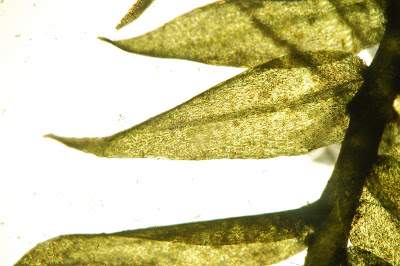Leptodictyum riparium (Hedw.) Warnst. (Amblystegiaceae)
Most common aquatic moss in central Florida is the Leptodictyum riparium (Hedw.) Warnst. (Amblystegiaceae). It is commonly found growing submerged on rocks along rivers, typically in thick mats, or exposed on rocks or tree bases close to water. Other aquatic mosses include some forms of Hygroamblystegium varium, and two species of Fissidens, which are much less common. Aquatic species of Sphagnum are confined to north Florida. Amblystegium serpens may be in our area, but voucher specimens need to be verified.
 |
| Leptodictyum occurs in thick underwater mats. The stems are long, straight and sparsely branched. The leaves are spread stiffly in one plane, even when dry. From Franck 3314 (USF). |
Leptodictyon is distinguished from other aquatic mosses by its long, straight, sparsely branched stems, with leaves extending stiffly from the sides of the stem (in more or less one plane). The leaves remain more or less stiff when dry, by may be somewhat rumpled. It rarely produces sporophytes in our area. Hygroamblystegium has shorter, more branched stems that tend to be more curved when dry, and shorter, more triangular leaves distributed uniformly around the stem. It is also more often found with sporophytes. Species of Fissidens are distinguished by their doubled leaves.
 |
| The leaves of Leptodictum have a distinct midrib, but which does not quite reach the tip. From Franck 3314 (USF) |
The leaves have a distinct midrib, and the leaf cells are generally elongate with thin, inconspicuous walls. Sporangia, when present, are somewhat curved and asymmetric, but none have been found among the specimens at USF.
 |
| The leaf cells are somewhat elongate and tapered at the ends, but do not stand out sharply under the microscope. From Lassiter et al 559 (USF) |
No comments:
Post a Comment